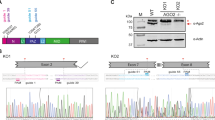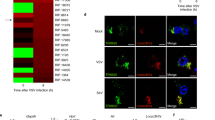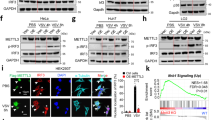Abstract
It has been known for decades that some clinically important viruses encode abundant amounts of non-coding RNAs (ncRNAs) during infection. Until recently, the number of viral ncRNAs identified was few and their functions were mostly unknown. Although our understanding is still in its infancy, several recent reports have identified new functions for viral microRNAs and larger ncRNAs. These results so far show that different classes of viral ncRNAs act to autoregulate viral gene expression and evade host antiviral defences such as apoptosis and the immune response.
This is a preview of subscription content, access via your institution
Access options
Subscribe to this journal
Receive 12 print issues and online access
$189.00 per year
only $15.75 per issue
Buy this article
- Purchase on Springer Link
- Instant access to full article PDF
Prices may be subject to local taxes which are calculated during checkout

Similar content being viewed by others
References
Birney, E. et al. Identification and analysis of functional elements in 1% of the human genome by the ENCODE pilot project. Nature 447, 799–816 (2007).
Carninci, P. et al. The transcriptional landscape of the mammalian genome. Science 309, 1559–1563 (2005).
Maeda, N. et al. Transcript annotation in FANTOM3: mouse gene catalog based on physical cDNAs PLoS Genet. 2, e62 (2006).
Mattick, J. S. & Makunin, I. V. Non-coding RNA. Hum. Mol. Genet. 15, R17–R29 (2006).
Pfeffer, S. et al. Identification of virus-encoded microRNAs. Science 304, 734–736 (2004).
Griffiths-Jones, S. miRBase: the microRNA sequence database. Methods Mol. Biol. 342, 129–138 (2006).
Lodoen, M. B. & Lanier, L. L. Viral modulation of NK cell immunity. Nature Rev. Microbiol. 3, 59–69 (2005).
Stern-Ginossar, N. et al. Host immune system gene targeting by a viral miRNA. Science 317, 376–381 (2007).
Dunn, C. et al. Human cytomegalovirus glycoprotein UL16 causes intracellular sequestration of NKG2D ligands, protecting against natural killer cell cytotoxicity. J. Exp. Med. 197, 1427–1439 (2003).
Gottwein, E. et al. A viral microRNA functions as an orthologue of cellular miR-155. Nature 450, 1096–1099 (2007).
Skalsky, R. L. et al. Kaposi's sarcoma-associated herpesvirus encodes an ortholog of miR-155. J. Virol. 81, 12836–12845 (2007).
Nair, V. & Zavolan, M. Virus-encoded microRNAs: novel regulators of gene expression. Trends Microbiol. 14, 169–175 (2006).
Sullivan, C. S. et al. SV40-encoded microRNAs regulate viral gene expression and reduce susceptibility to cytotoxic T cells. Nature 435, 682–686 (2005).
Grey, F. et al. A human cytomegalovirus-encoded microRNA regulates expression of multiple viral genes involved in replication. PLoS Pathog. 3, e163 (2007).
Lo, A. K. et al. Modulation of LMP1 protein expression by EBV-encoded microRNAs. Proc. Natl Acad. Sci. USA 104, 16164–16169 (2007).
Pfeffer, S. et al. Identification of microRNAs of the herpesvirus family. Nature Methods 2, 269–276 (2005).
Mathews, M. B. & Shenk, T. Adenovirus-associated RNA and translation control. J. Virol. 65, 5657–5662 (1991).
Fok, V. Friend, K. & Steitz, J. A. Epstein–Barr virus noncoding RNAs are confined to the nucleus, whereas their partner, the human La protein, undergoes nucleocytoplasmic shuttling. J. Cell Biol. 173, 319–325 (2006).
Ruf, I. K. et al. Protection from interferon-induced apoptosis by Epstein–Barr virus small RNAs is not mediated by inhibition of PKR. J. Virol. 79, 14562–14569 (2005).
Reeves, M. B. et al. Complex I binding by a virally encoded RNA regulates mitochondria-induced cell death. Science 316, 1345–1348 (2007).
Burnside, J. et al. Marek's disease virus encodes microRNAs that map to meq and the latency-associated transcript. J. Virol. 80, 8778–8786 (2006).
Lu, S. & Cullen, B. R. Adenovirus VA1 noncoding RNA can inhibit small interfering RNA and microRNA biogenesis. J. Virol. 78, 12868–12876 (2004).
Xu, N. et al. Adenovirus virus-associated RNAII-derived small RNAs are efficiently incorporated into the RNA-induced silencing complex and associate with polyribosomes. J. Virol. 81, 10540–10549 (2007).
Higgins, G. D. et al. Presence and distribution of human papillomavirus sense and antisense RNA transcripts in genital cancers. J. Gen. Virol. 72, 885–895 (1991).
Liu, Z., Batt, D. B. & Carmichael, G. G. Targeted nuclear antisense RNA mimics natural antisense-induced degradation of polyoma virus early RNA. Proc. Natl Acad. Sci. USA 91, 4258–4262 (1994).
Lukac, D. M., Kirshner, J. R. & Ganem, D. Transcriptional activation by the product of open reading frame 50 of Kaposi's sarcoma-associated herpesvirus is required for lytic viral reactivation in B cells. J. Virol. 73, 9348–9361 (1999).
Prang, N., Wolf, H. & Schwarzmann, F. Latency of Epstein–Barr virus is stabilized by antisense-mediated control of the viral immediate-early gene BZLF-1. J. Med. Virol. 59, 512–519 (1999).
Zhang, G. et al. Antisense transcription in the human cytomegalovirus transcriptome. J. Virol. 81, 11267–11281 (2007).
Yu, W. et al. Epigenetic silencing of tumour suppressor gene p15 by its antisense RNA. Nature 451, 202–206 (2008).
Cook, H. L. et al. Small nuclear RNAs encoded by herpesvirus saimiri upregulate the expression of genes linked to T cell activation in virally transformed T cells. Curr. Biol. 15, 974–979 (2005).
Ambros, V. The functions of animal microRNAs. Nature 431, 350–355 (2004).
Du, T. & Zamore, P. D. microPrimer: the biogenesis and function of microRNA. Development 132, 4645–4652 (2005).
Yekta, S., Shih, I. H. & Bartel, D. P. MicroRNA-directed cleavage of HOXB8 mRNA. Science 304, 594–596 (2004).
Mansfield, J. H. et al. MicroRNA-responsive 'sensor' transgenes uncover Hox-like and other developmentally regulated patterns of vertebrate microRNA expression. Nature Genet. 36, 1079–1083 (2004).
Vasudevan, S., Tong, Y. & Steitz, J. A. Switching from repression to activation: microRNAs can up-regulate translation. Science 318, 1931–1934 (2007).
Kim, V. N. MicroRNA biogenesis: coordinated cropping and dicing. Nature Rev. Mol. Cell Biol. 6, 376–385 (2005).
Acknowledgements
Thanks to the members and friends of the Sullivan laboratory for comments regarding this manuscript. Research in the Sullivan laboratory is supported by University of Texas (UT) at Austin start-up funds and a UT Austin Institute for Cellular and Molecular Biology Research Fellowship.
Author information
Authors and Affiliations
Related links
Rights and permissions
About this article
Cite this article
Sullivan, C. New roles for large and small viral RNAs in evading host defences. Nat Rev Genet 9, 503–507 (2008). https://doi.org/10.1038/nrg2349
Published:
Issue Date:
DOI: https://doi.org/10.1038/nrg2349
This article is cited by
-
Transforming activity of an oncoprotein-encoding circular RNA from human papillomavirus
Nature Communications (2019)
-
Two host microRNAs influence WSSV replication via STAT gene regulation
Scientific Reports (2016)
-
In-depth profiling and analysis of host and viral microRNAs in Japanese flounder (Paralichthys olivaceus) infected with megalocytivirus reveal involvement of microRNAs in host-virus interaction in teleost fish
BMC Genomics (2014)
-
Regulatory long non-coding RNA and its functions
Journal of Physiology and Biochemistry (2012)
-
Progress and prospects: Immunobiology of gene therapy for neurodegenerative disease: prospects and risks
Gene Therapy (2010)



